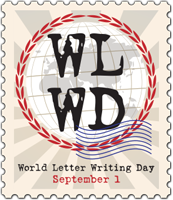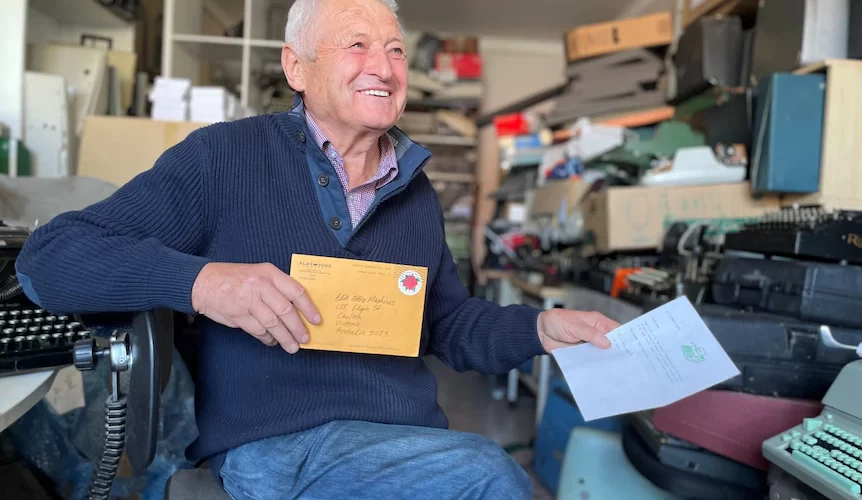From me, with love: the lost art of letter writing
Three years ago, novelist Jon McGregor invited strangers to send him a letter in the post. Scribbled notes and love letters are still landing on the doormat…Our first letter was from Magnus Mills. It came in a plain brown envelope, and was handwritten on a plain sheet of white A4. “Dear J,” it began. “Thanks for asking and I’m really very flattered, but I don’t think I’ll be able to supply a handwritten letter.” It went on to explain the ways his time was taken up with work or with thinking about work. It was thoughtful and well-written, and concluded with: “Therefore, I’m sorry but there’ll be no letter.” Uncertain whether the irony was deliberate (but assuming, coming from the author of the deadpan The Restraint Of Beasts, that it probably was), we went ahead and published his letter-that-wasn’t-a-letter anyway.
The starting point for the Letters Page was a simple one. I was taking up a job teaching creative writing at the University of Nottingham, and I wanted to encourage the students to think about writing in ways that didn’t involve blank sheets of paper or screens. I wanted them to think about other people’s writing before they started to think about their own, and decided that a good way of doing this would be to set up a literary journal and have the students produce it; reading the submissions, making selections, putting each issue together.
But I wanted it to be a literary journal that could find an underhand way of being literary; to take the self-consciousness out of being literary. I’ve always been interested in the kinds of writing people do when they don’t think they’re being asked To Write, and I’d been thinking about letters as a form; wondering about the differences between letters-on-paper and emails, reflecting on my own letter-writing history, noticing the democracy of correspondence as a literary practice. So the idea was born.

I asked people to send us letters; real letters, written by hand and sent through the post. I sat in the office with my student assistants and waited for the letters to arrive. There was something exciting about sorting through the pile, letters from Canada and the US, from Spain and Germany and France, from Donegal and Dublin and Brighton and Tring. We set to work with the letter knives and started to read. I was hoping that they would, while still being framed as letters, take the form of stories, essays, poems, memoir, criticism. What actually happened was that almost everyone wrote about the nostalgic and rare pleasure of sitting down to write a letter at all.
I grew up writing letters. They were a big part of making me the writer I am today, I think. As a child there were thank you letters, of course, ruining the long weeks after Christmases and birthdays. And postcards. Letters to the Beano, and Blue Peter, and – now tainted – letters to Jim’ll Fix It. (I wanted to drive a combine harvester, thanks for asking.)
As I grew older, I seemed to accumulate penpals the way other people collected football stickers, and by my late teens I was sending and receiving two or three letters a day. Much of what I wrote then would have been standard teenage diary stuff, about how terrible my life was and how brilliant the Smiths were; but over time, much more of what I wrote became about storytelling.
I was commuting 30 miles a day to college, and spent the time writing about the people I saw on those journeys; and what I didn’t know, I made up. Without really thinking about it, I was experimenting with ways of telling a story, ways of holding a reader’s attention, playing with voice and form and technique; and the friends writing back were doing the same. The boundary between fact and fiction was blurred, but in truth we were only asking about each other’s lives. Through these letters, I was learning about the small corners of the world my friends inhabited: in towns in Dorset and Devon, in south Wales, in north London, in the West Midlands, in Kent. These letters were making physical journeys from places I’d never been, bringing news from elsewhere.
I kept writing letters throughout my time at university. The first time someone gave me their email address, I looked at it as though it had no more relevance to my life than someone’s CB radio handle. But, of course, email crept gradually into my life, initially as a sort of proto-text-messaging, for occasions when quick and simple communication was required. And there was a long period of overlap where I would email someone to let them know I was writing a letter and would soon be posting it. But at some point the balance tilted, and letter-writing became something that happened by choice rather than by default; something a little self-conscious or mannered, something that started to feel like a duty or a task, and so was never quite done; until I moved house a few years later and realised there was no one I needed to tell. My email address wasn’t changing, and my physical address no longer counted. My letter-writing days were over.
It’s been boom time for nostalgia about letter-writing lately. You can always tell that a cultural form is dying when people start making a point of celebrating it. (See also: typewriters, Polaroid photographs, vinyl records.) There have been the excellent Letters Of Note books edited by Shaun Usher, with its accompanying Letters Live stage shows; the Letters In The Mail subscription service run by rumpus.net, where you get a letter from an interesting writer every two weeks; and a whole series of books and articles either celebrating letters, or decrying email, or both.
The letters that started arriving in Nottingham were, on the whole, addressing themselves to this idea of the loss of letter-writing. They were often remarkably self-conscious about the process of sitting down to write. There were many apologies for poor handwriting, and sometimes these were justified. There were references, towards the end of letters, to aching hands. There was some confusion about the cost of stamps. And there was a lot of talk about the letters people had written in the past – about penpals, and relationships maintained across distances, about letters written from the army or from prison or from school – and a lot of talk about when exactly the habit had fallen away.
The Irish novelist Colum McCann wrote fondly to us of his own letter-writing history, and of the letters he has received. “I don’t stack them away in neat little piles,” he wrote, “but sometimes I do leave them lying around my office, so that I can open them and let them surprise me.” He referred also, as many people did, to collections of letters as personal archive material, mentioning a crate of letters his father kept in a shed. “He has told me that I can read the letters at any time. I have told him that I will wait until he is gone. And he tells me that in that crate, those letters, he will never be gone.”
McCann’s letter took a little deciphering, because, while the handwriting itself was immaculate, there were all manner of sidenotes and endnotes tucked into the margins and arrowed between paragraphs. This was quite a theme in many of the letters we received; just how disorderly a handwritten text can be, compared with the linearity of a document on a screen. There were crossings out and rewritings, marginalia, diagrams and doodles, cover notes and Post-it notes and extra scraps tucked into the envelopes. There were pressed flowers, and bookmarks, and even a lock of hair. At least two letters arrived stuffed into plastic bottles, the stamps held on with sellotape and hope. Selma Dabbagh wrote us an abandoned love letter, retrieved from a hotel waste basket and sent as a scrumpled ball. Ruth Gilligan wrote a letter to God, folded into a tightly wedged note as though ready to be pushed into a crack in the Western Wall. Some of the letters were scented, and not always deliberately. Some were torn, and stained, and all of them bore the traces of the journey they had made from the place where they were written. They were physical objects, with all the tactility and uniqueness and marks of time which that implies, and it became more apparent than ever that these marks of time are what distinguish letters from emails and other forms of digital correspondence.
The wonderful thing about email is its immediacy. A conversation can be had – a decision made, a plan refined – in a matter of minutes, no matter where in the world the two parties happen to be. A letter, by contrast, always arrives from the past. There is a waiting – a forced patience – built into the mechanics. You wait for a letter to arrive. You wait for a reply. In the time it takes for the letter to reach its destination, anything can happen: minds be changed, lives lost, loves discovered.
This sense of duration was also borne out by how many of the letters we read wanted to give a sense of where they were, in both space and time: I am sitting at the kitchen table; I am in the garden, under the apple tree; I can hear the children in the bath upstairs and will soon have to fetch them. In that sense, a letter is more “composed” than an email.
But these differences between letters and emails are just that: differences. One is not better or worse than the other. In many ways, the differences hold in microcosm the wider cultural shift away from reading in print to reading on screen. For some people, there will always be something more transient about the latter. There is an astonishing wealth of information on the devices we carry around with us – a wealth that should be celebrated – but it can be difficult to concentrate on one piece of information at a time; to read a single article or book with the kind of deep, measured concentration that seems to come more naturally with print. A printed book stays on your shelf, and can be bookmarked, annotated, flicked through, shared. I know, I know: these things are all possible with digital devices, and they may come naturally to some people. This might just be me. But you don’t have to be an ink-sniffing stationery fetishist to think that perhaps the technology of the printed book is more durable and user-friendly than some people have started to give it credit for.
If I write: ‘first kiss’… and you feel something… suddenly we are in direct connection, mind to mind
Because here’s something I’ve noticed: people really do like having something to hold. I should have mentioned that, despite setting out to celebrate the physicality of the handwritten letter, until this month we published only online, relying on our readers either to print out and savour each issue, or to read it on a screen of their choice. And it’s become clear that, even as the number of our subscribers continues to grow, there has been less engagement with each issue; fewer downloads, fewer responses. It seems as though the format is too ephemeral, too transient; the very opposite of the letters that continue to arrive through our letterbox.
Which is why, because I am an actual ink-sniffing stationery fetishist, we’ve now published them in print. There are letters from the novelists Naomi Alderman, Andrey Kurkov, Joanna Walsh, Kevin Barry and others. But the closing letter, fittingly, is from a retired postal worker in Alberta, Canada – Ken Sears. He writes about the letters he sorted during his career, and how he learned to spot the ones from prison, from lovers, from the person with hypergraphia, or people behaviourally compelled to write; and about how now, in retirement, despite a lifetime of seeing most of the mail he sorted as just so much landfill, he continues to write letters, “Because it’s a big, cold universe, and it feels just a little warmer believing there’s somebody out there, somewhere, who knows you’re still alive. I’ll keep on writing them, and the brothers and sisters down at the local PO will keep shoving them along. They make a few bucks. I draw my pension. I learn a few things and everybody’s happy.”




This Post Has 0 Comments